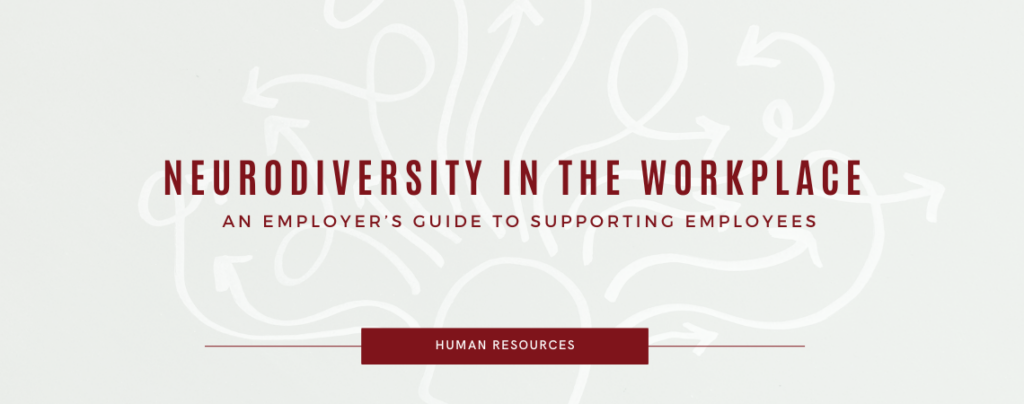
Neurodiversity is a simple but powerful idea: our brains work in different ways. And that’s a good thing!
There are an estimated 600,000 neurodiverse adults in Canada. That’s a whole lot of brainpower showing up differently (and brilliantly) across our teams.
In the workplace, this includes both neurotypical and neurodiverse folks. Neurotypical = brains that operate in ways society sees as “standard.” Neurodiverse = people with neurological differences like Autism Spectrum Disorder (ASD), ADHD, learning disabilities, and more. Spoiler: there’s no “one right way” to think, communicate, or work.
Today, we’re focusing on autism in the workplace. ASD is a developmental condition that affects how people experience the world, communicate, and interact with others. People often use the term “on the spectrum” because autism can look very different from person to person.
Common Misconceptions
There are many myths about autism. Let’s start by debunking a few of them.
Let’s get this one out of the way: “People with ASD can’t succeed in a professional setting.” False. Wrong. Nope. In reality, many individuals on the spectrum thrive at work with the right support and environment. Neurodiverse folks bring unique strengths like attention to detail, deep focus, innovative thinking, and a strong sense of integrity.
Another big one? That all autistic people are the same. Not even close. ASD is called a “spectrum” for a reason — every person is different, with their own mix of strengths, preferences, and challenges. Kinda like… literally everyone else?
There’s a quote from Dr. Stephen Shore that goes: "If you've met one individual with autism, you've met one individual with autism." So, while certain traits and experiences often show up together, each person’s experience can be very different!
How Autism Can Show Up at Work
Employees with autism often bring incredible strengths to the table, such as strong focus, attention to detail, creativity, and unique problem-solving skills. At the same time, their experience in the workplace might look a little different. For example, they might:
- Prefer routine, structure, and clear instructions (honestly, who doesn’t?)
- Avoid small talk or eye contact — this isn’t being rude, it’s just how they process social cues
- Need extra time to process info or respond in meetings
- Take language literally (so avoid sarcasm, idioms, and other figurative language)
These differences are simply that: differences! Think of it like stepping into a new culture. What’s “normal” to you might feel unfamiliar – even overwhelming – to others. That’s why inclusive workplaces matter.
What You Can Do as an Employer
Supporting neurodiverse employees doesn’t require a complete overhaul. You don’t need a fancy toolkit or a PhD in psychology to be more inclusive. It starts with awareness and a few thoughtful changes:
- Accessible from the start: Build inclusion into your workplace culture. Schedule regular social time that’s clear and optional, and structure meetings with agendas so everyone can prepare.
- On that note – use agendas: Having a plan helps reduce anxiety for everyone, not just neurodiverse team members. (#BringBackAgendas2025 – why doesn’t anyone use them anymore?!)
- Offer flexible schedules: Let people work when they’re most productive. For some, that might mean getting a few extra hours of sleep in the morning but putting in the work in the evenings. For others, it might look like taking regular breaks throughout the day.
- Get to know your team: Genuinely take the time to get to know your team. It’s not rocket science! Ask what works best for them. Everyone thrives in different ways.
- Create clear systems: Written processes, checklists, and setting expectations go a long way. Start simple with getting clear systems in place for your team!
- Listen to the voices of those with autism: The best way to understand what works is to hear directly from employees with autism. Create opportunities for feedback and treat neurodiverse team members as experts in their own experiences.
- Use personality and communication tools: Personality or communication-style assessments can help your team (including folks with ASD) better understand how to communicate and collaborate. They offer helpful insights into working styles, which can reduce misunderstandings and improve team dynamics.
The goal here isn’t to single anyone out – it’s simply to make your workplace a space where everyone has what they need to succeed.
Where Inclusion Meets Impact: Your DEI Strategy Starts Here
Creating an inclusive workplace that supports neurodiversity is one of the best things you can do as an employer. Inclusive, accessible workplaces foster stronger teams, increase innovation, and help you attract and retain top talent from all backgrounds.
At Envol, we go beyond check-the-box inclusion. We partner with employers across North America to integrate diversity, equity, and inclusion (DEI) meaningfully into your overall business strategy — making inclusion part of how you hire, lead, and grow.
From practical training and inclusive hiring practices to customized workplace policies and accessible design, we help you build a culture where everyone can bring their authentic selves to work.
Have questions or ready to take the next step?
Book a call with our team. We’re here to help you make your workplace more inclusive, more accessible, and honestly… just better for everyone.
Additional Learning Resources
- Punk Rock HR Ep, 289: Autism at Work with Dr. Lisa Scott (Podcast)
- Harvard Health Publishing: What is Neurodiversity?
- What it Means to be Neurodivergent
- Autism Doesn’t Hold People Back at Work. Discrimination Does.
Share this blog with your network!


